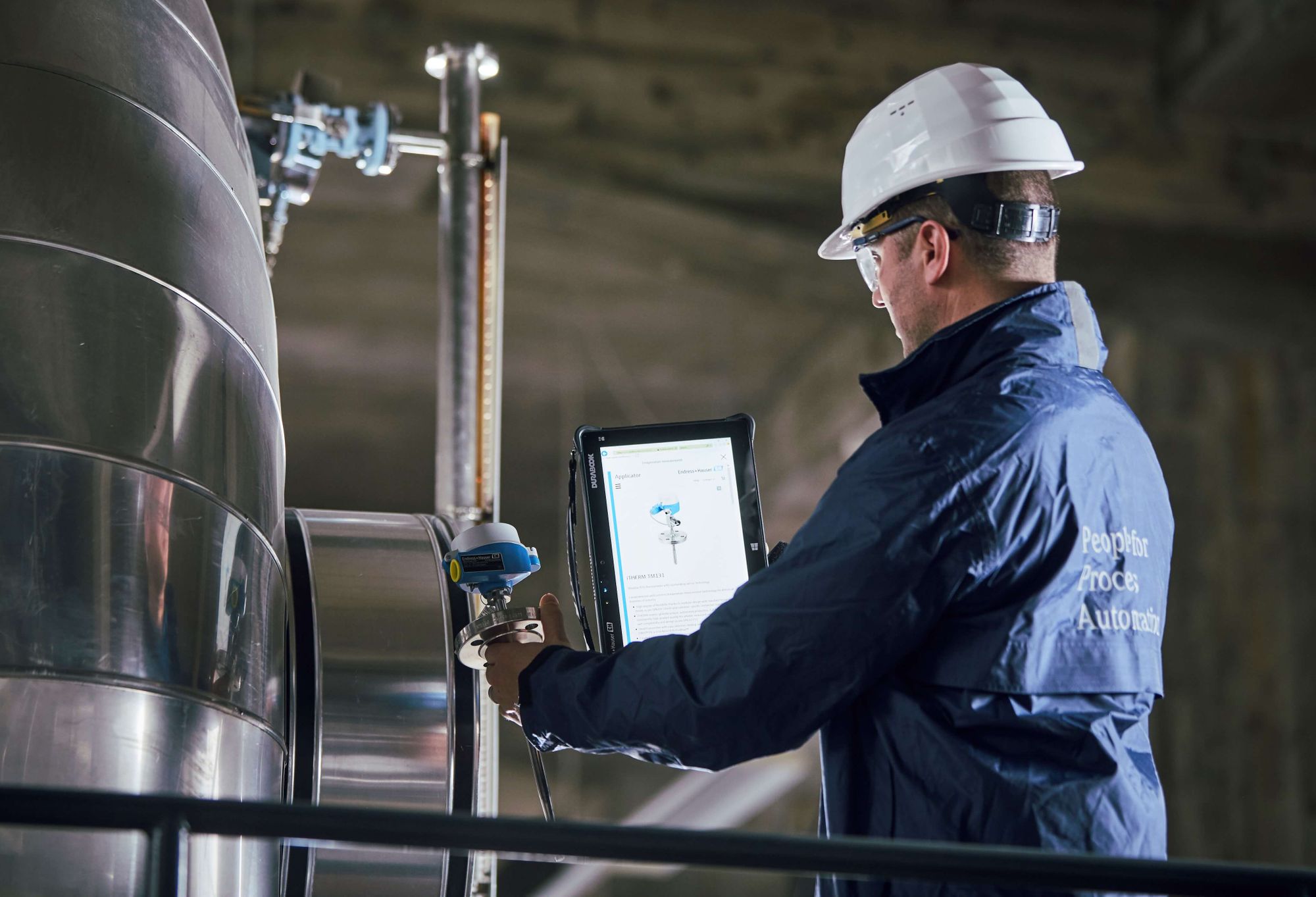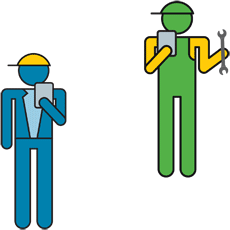The Field Communicator and how to use it with IIoT Services
A field communicator is already an essential tool to get access to all your field device’s information, but how do you use it together with an IIoT service?
Back in the days when devices had only 4-20 mA signals, the multimeter used to be an essential tool for your daily tasks or at least for a lot of you, right? But I bet that a field communicator is now your primary tool to get tasks done.
Over the years, the field communicator has changed, even though the name has not. Today, it's not a normal handheld, but a tablet with a lot of features that can assist you in many activities during your daily business.
I also know that sometimes, because of daily routines, you don't have time to explore the full potential of these smart tools. On thinking about it, I decided to share with you how the full potential of this powerful new tool can be explored at your plant.
Let's look at the origins of the handheld and its evolution over the years. Afterwards I’ll tell you how it can help to optimize your activities today by using it together with Industrial Internet of Things services.
Find a place to chill, grab something to drink and eat, and let's dive into this topic today.
First experience with a field communicator.
Monday, 2007, 18:00 hours: A young student is running fast along the street in the direction of the technical college.
“I am late! After a day at work, I have to run to have my first hands-on class. Oh man, I am looking forward to it! You know, everyday I see a lot of fieldbus devices in our pilot plant and I really want to start to explore everything”, thought the student during his run to the technical college.
“I finally made it! Five minutes late – wow, that’s almost too early for a Brazilian! The teacher will not even notice me, I guess…”
“It's good to see you in my class”, said the teacher after the student found his place.
“My fault for being late!” He answered, causing his fellow students to laugh.
After another five minutes, the teacher finally started his class. “Now, after the last one has arrived, it's time to learn more about instrumentation. Last week, we learned what instrumentation and automation are - the devices and systems - and more about ISA 5.1.
Today, let's have our first hands-on class. What we are going to do is set up a pressure transmitter, apply pressure, and measure its output after the configuration. It helps us to double-check if the setting was done correctly.”
When the teacher was finished, an innocent student raised his hand and asked:
“Teacher, are we going to use a handheld to make this configuration?”
“Of course we are going to use a handheld”, answered the teacher “, but a different one.”
For a moment, the class was silent, trying to understand which tool they were about to use in the first hands-on class. Then, quickly, the teacher took a tiny screwdriver from his t-shirt pocket and said “before we jump into the new handhelds, I will show you how everything started. Today, we are going to learn how to configure a 3-15 psi pneumatic pressure transmitter.”
Everyone was very excited to learn about the new trend called fieldbuses in 2007, but nobody was expecting a pneumatic device.
“Nothing better than starting from the beginning”, concluded the teacher.
With clear question mark on her face, another innocent student raised her hand and asked: “Is there any 3-15 psi device still out there? Come on; we are in 2007, how can it be possible?”
The teacher answered by just smiling back at the questioner.
What is a field communicator?
It took me many years to understand, but even in 2019, you still can find some of these pneumatic devices lost out there working as they always have. And yes, the screwdriver was still the configurator when the first 4-20mA devices arrived after the pneumatic ones.
When the first HART and proprietary protocols (like Honeywell’s DE or Endress+Hauser’s Intensor) arrived, we started to see some field communicators pop up on the market. At the same time, local displays started to appear on some devices, but the user experience was better with the field communicator.
After a while, the field communicator or handheld, also known as a HART Configurator, became popular. At this time, HART was the only open protocol, which is why it got the name. It took a couple more years before other open protocols came onto the market.
Later versions of the field communicator had both HART and Foundation Fieldbus connectivity. In short, the idea of the tool was to get access to the menu tree of the field devices. To do it they needed, depending on the model, (Electronic) Device Description (DD/EDD) or DTM files.
These files basically give you access to the entire menu of the device and you can do the full setup and check other information too. However, one situation used to happen quite often and still happens today from time to time.

It is known as generic access to the device. If you have to use generic access you won’t be able to do a lot of things because you don’t have access to the entire menu tree.
The reason for that is the library of the field communicator does not have the DD/EDD or DTM files for the device being set up. Maybe it’s a new device type or has a new version of the firmware. The user usually only realizes this when it actually happens. I’m telling you, because I used to do technical support daily and this kind of problem used to happen very often.
Nowadays, many things have changed! The process of keeping your field communicator up to date is far more comfortable than before. Furthermore, field communicators now offer an extensive list of connectivity.
You can work with many protocols and have many tools running on it, making your life much easier. Much better than carrying all that stuff across the plant, right?
How to use the field communicator?
If you are not familiar with field communicators, they usually give you many possibilities. Here, let me give you a simple overview of the basic functionality of a field communicator! Later, I will jump into the new options that were created when this tool became a tablet.
Configuration: the basic function of a field communicator is to give you access to the device’s menu! I guess, if it doesn't give you this essential function, then maybe you don't have a handheld! As I said, depending on the device, you can use different files at the library, it can be the DD/EDDs or DTMs! Today, FDI is a new thing popping up, but it's not quite “real” yet.
Diagnostics: another primary way to use your field communicator is to check the diagnostic information from your field device! The new files offer a bunch of relevant data regarding the health of your field device! On the downside, in most cases you have to connect to the loop or at least to be in front of the device. On the upside, you can now have an IIoT service, such as Netilion Health, to collect to this information remotely.

Envelope curve: if you are using radar transmitters to measure level, it's sometimes necessary to have a look at the envelope curve! The new type of field communicator, industrial tablets such as the Field Xpert SMT70/SMT77, gives you an excellent user experience to check this information on the screen without the necessity of having a laptop.
Heartbeat technology: some field devices already offer advanced technology to monitor the health status of your field instrumentation! For instance, a good part of the Endress+Hauser product portfolio gives you the option of Heartbeat technology, so that you can collect advanced information about the health of your field instrumentation.
These are just some examples of basic functions of a field communicator. What more you can have with IIoT services? Let's find out.
How to update a field communicator?
Before we go on to IIoT services and field communicator, let’s talk about how to keep the field communicator up to date. This means that firstly, you have the latest version of the software and maybe some new features. Secondly, you have your library with the latest version of the DTMs or DD/EDDs for the many devices on the market.
The procedure used to be very complicated, requiring the connection of your field communicator to a laptop, in some cases using infrared communication. When I used infrared, I was always afraid that files would be corrupted during the transfer from the computer to the field communicator.
Nowadays, we have a better scenario. The procedure to keep your library and software up to date is very straightforward and the field communicator itself can communicate with the server to download the data.
Field Xpert SMT70 and SMT77, for example, offer you a straightforward procedure to ensure you have all the latest DTM files and software, avoiding the problem of generic communication.
How to work with more efficiently using a field communicator and IIoT services?
Nowadays, field communicators are industrial tablets providing a platform on which you can have many applications. This reminds me of a situation a long time ago, when I visited customers with a field communicator with a limited library.
This was because the memory was full. So, I also had to take my laptop with the HART interface and other software just in case the field communicator didn’t work.
The reality today is very different: the industrial tablet provides you with the flexibility and security to work the same areas as with the standard handheld together with features you know from laptops.
This means that IIoT service solutions and the latest field communicators work smoothly together and you have access to many applications. As an example, let’s take Netilion Library and Field Xpert SMT70.

When you use these two solutions together, you can greatly improve the efficiency of the daily work on your field devices and also smartly manage all the associated documentation.
Rather than trying to find all the documentation online every time you need to set up or to troubleshoot a device, you can have all relevant files and documents in the cloud and access them with Field Xpert.
Furthermore, all your team can cooperate and share files. This helps the team to save time in checking past documents concerning calibration, maintenance or any other file saved to the device.
It’s pretty much all I have to say today. Any questions?
So, if you liked this article, don't forget to share it on social media using the #netilion.
Finally, if you want to have a look at the Netilion Services, you can sign up and try it for free.



